Mercury (Hg) energy savings bulb. Canon 450D
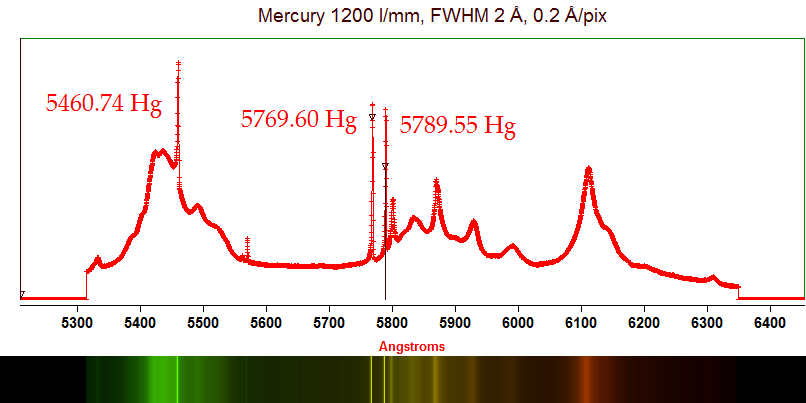
This is an Osram energy savings fluorescent bulb. Unfortunately, these have Mercury in them, but it makes a good calibration lamp with some sharp lines. However, a huge bulb like this suits best outside the spectrograph or in front of the telescope in combination with a diffuser.
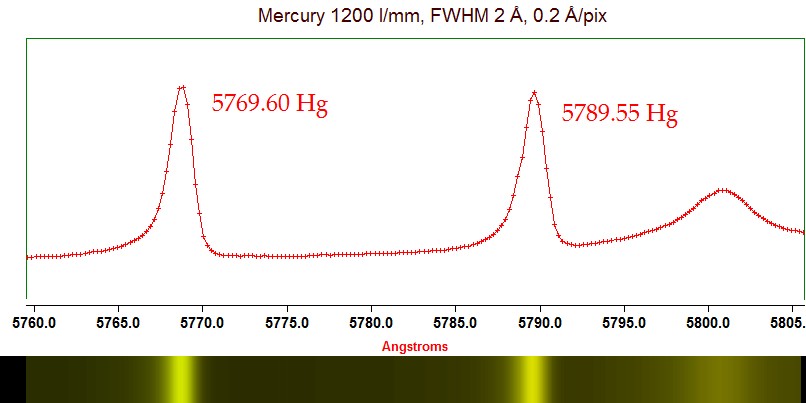
Zoomed version. We see a spectral resolution of about 2 Angstroms (FWHM - Full Width Half Modulation; assuming that the profiles are purely an instrument response arising from a "delta function" for the true line profile, which is not really accurate) obtained at n=1 with a sampling rate at 0.2 Angstroms per pixel. Canon 450D camera. The asymmetric shape of the profiles may be an instrument artifact.
Osram ST 111 4-80 W glow starter, in continuous glow mode! (H, Ar).
Testing the ST6.
This brilliant idea was found on Richard Walkers website, where he explains that a simple starter for standard fluorescent tubes can be run continuously by just hooking it up to 220 V or 110 V AC by soldering on a suitable resistance (at your own risk, obviously). The result is a fantastic Hydrogen and Argon emitter that I can mount inside my spectrograph for direct calibration of the Hydrogen Balmer lines! This glows moderately with an eerie bluish color, so it looks cool as well.
This was the first test with the ST6 camera, that has relatively large pixels, of 23x27 microns, compared to the Canon camera and more modern CCD's which have pixes sizes on the order or 5x5 microns. The ST6 sensor has only 375 x 241 pixels and as a result, the wavelength range is only about 200 Angstroms with 0.5 Angstrom sampling rate, and this is achieved with a camera lens focal length of 400 mm with the current setup, using the 1200 l/mm grating.
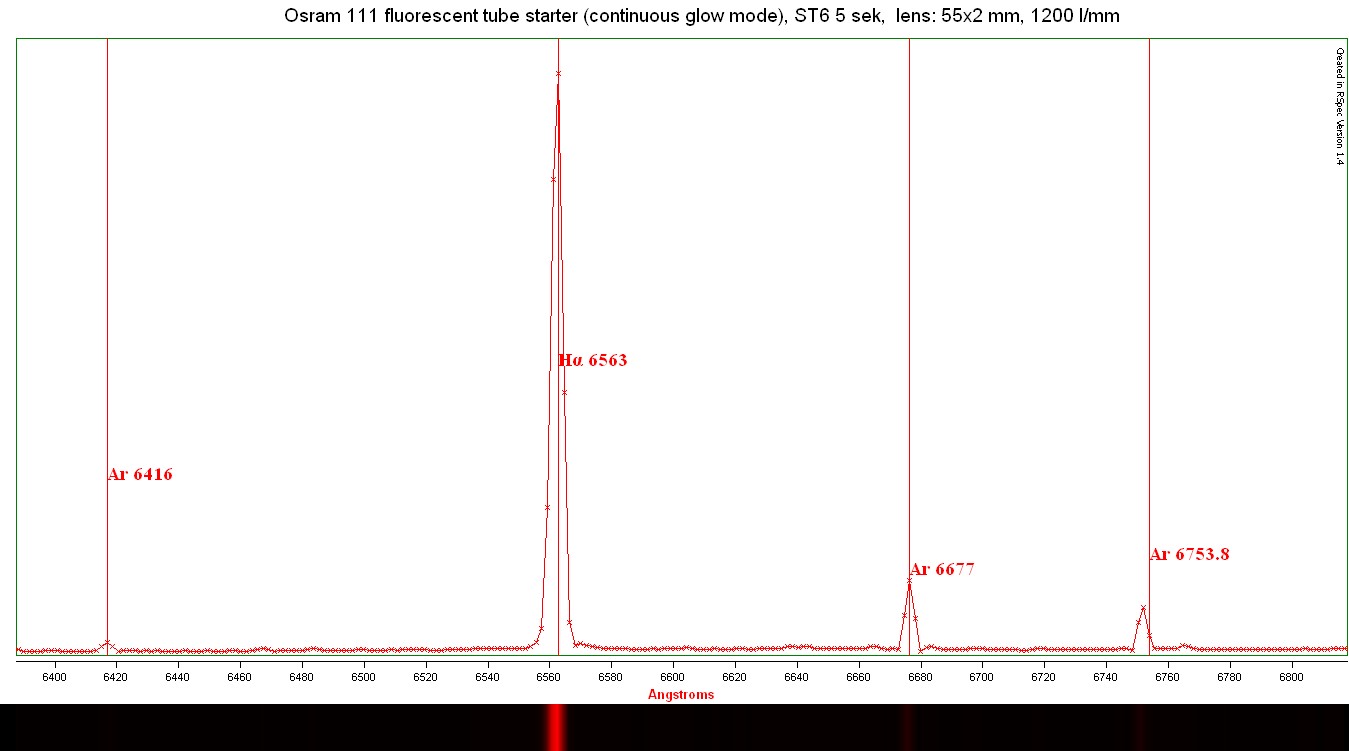
This is the Hydrogen Alpha line, plus some Argon emission, taken with the ST6 camera.
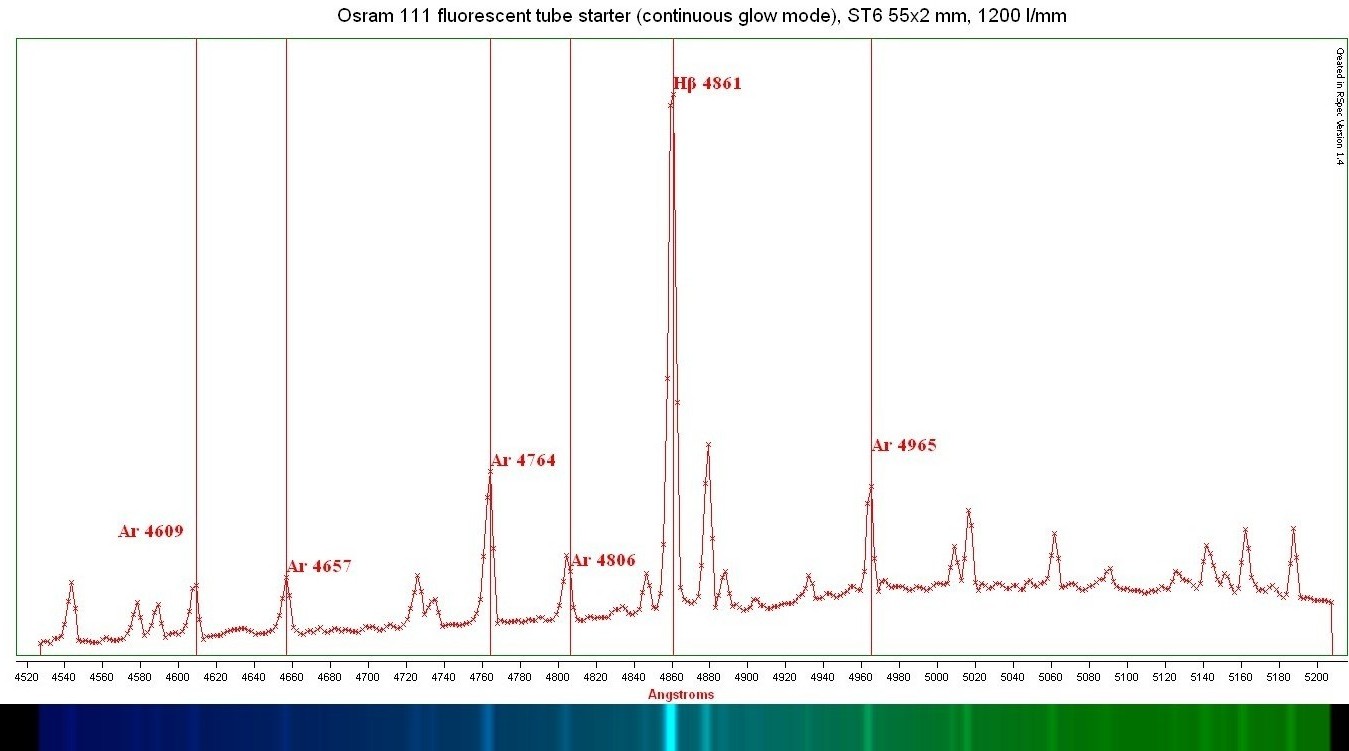
Moving on towards the blue, we enter Hydrogen Beta with some Argon, and possibly a continuum in the background.
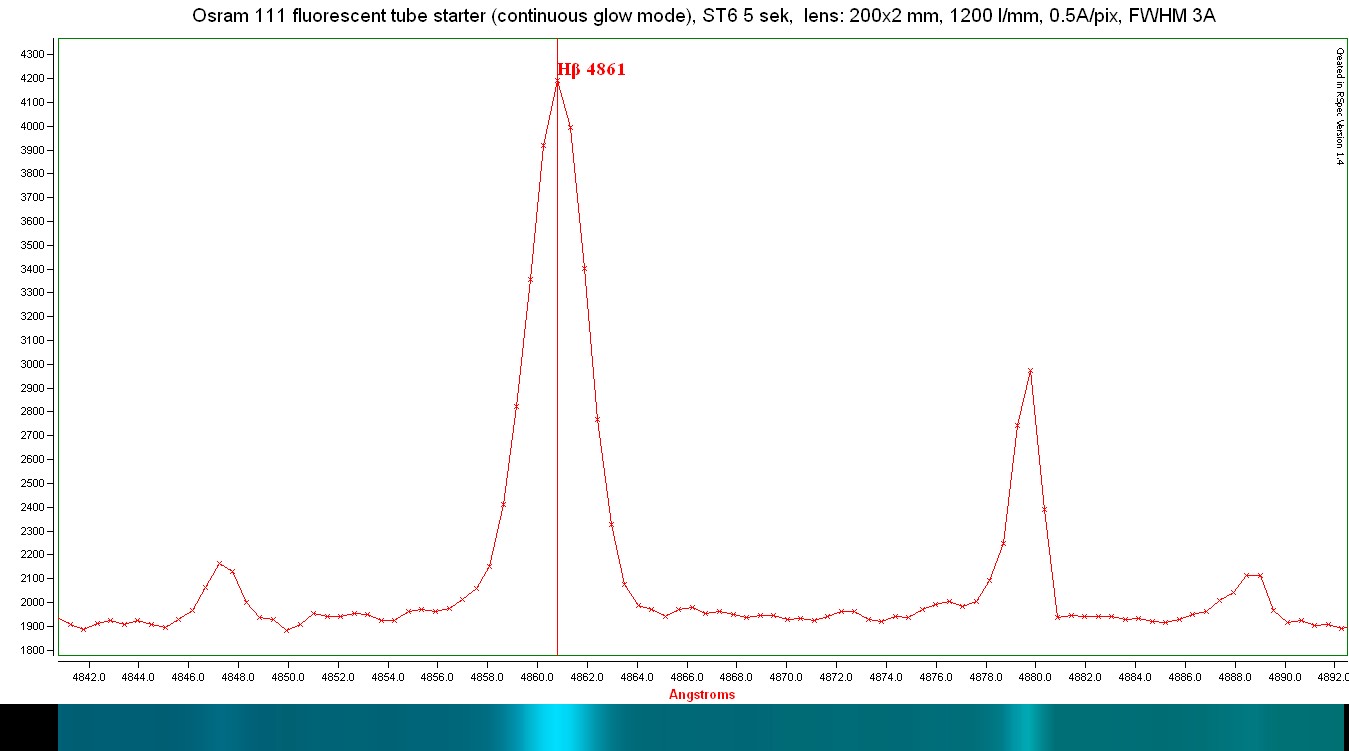
With a 200 mm lens with a 2x teleconverter one obtains one half the sampling rate (0.5 Angstrom/pix vs 0.2) with the ST6 as compared to the Canon camera with the single 200 mm lens (ST6 has larger pixels). The FWHM was here measured at 3 Angstroms. Only a subsection of the spectrum is shown.
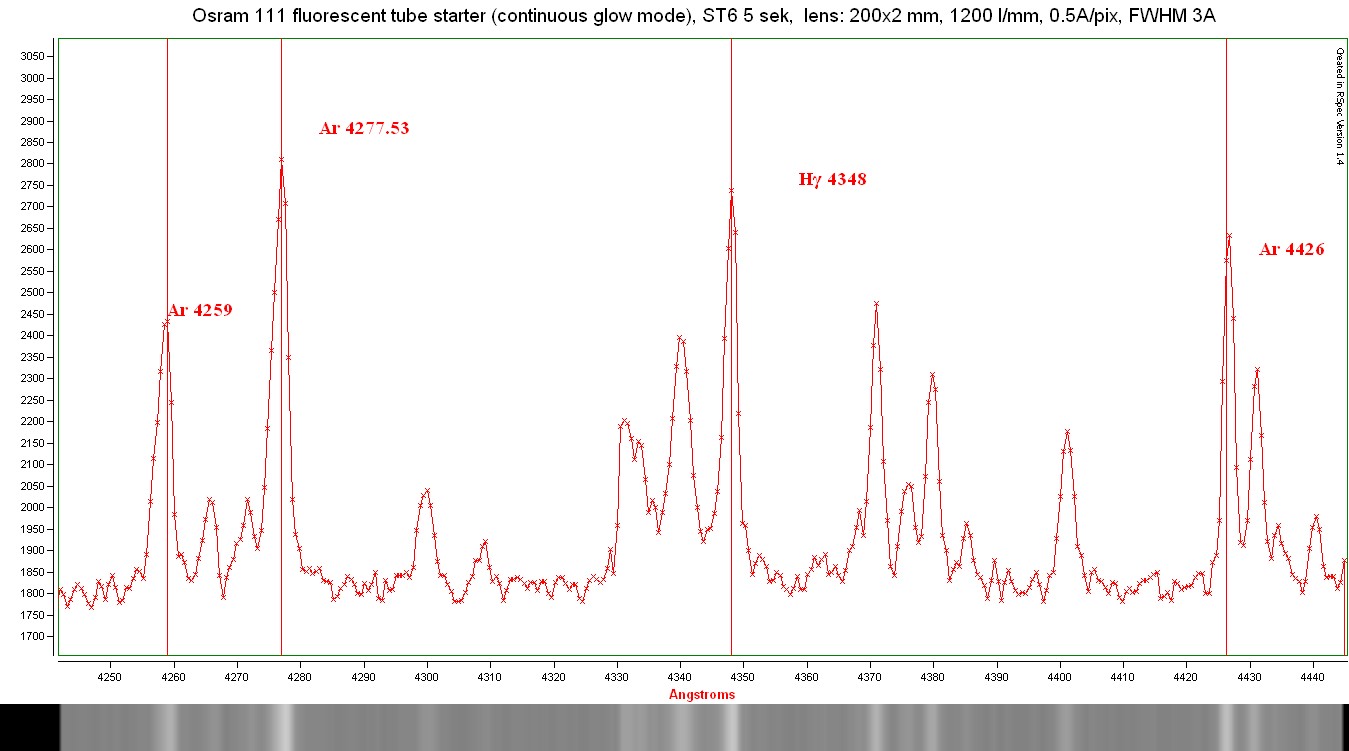
Moving on further towards the blue, we enter Hydrogen Gamma with some Argon.
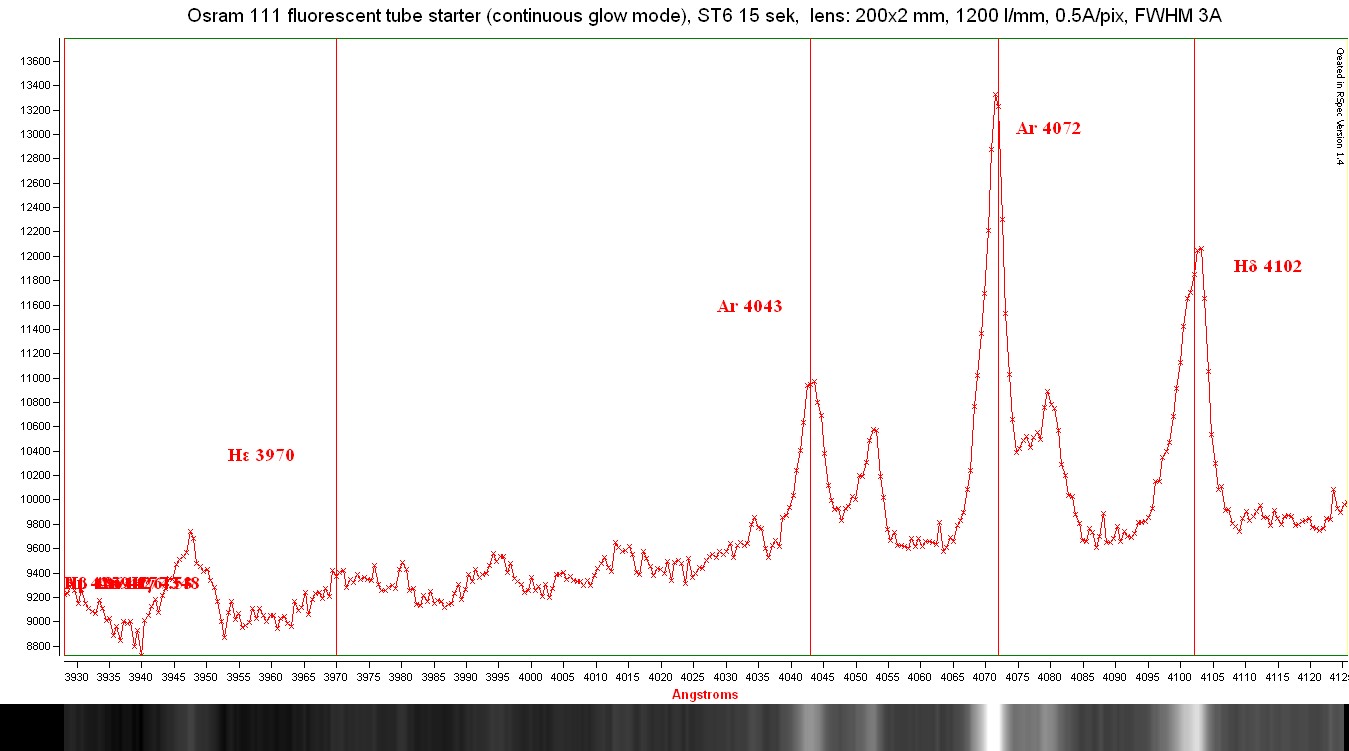
Moving on even further towards the blue, we enter Hydrogen Delta and possibly Epsilon (?), with some Argon.
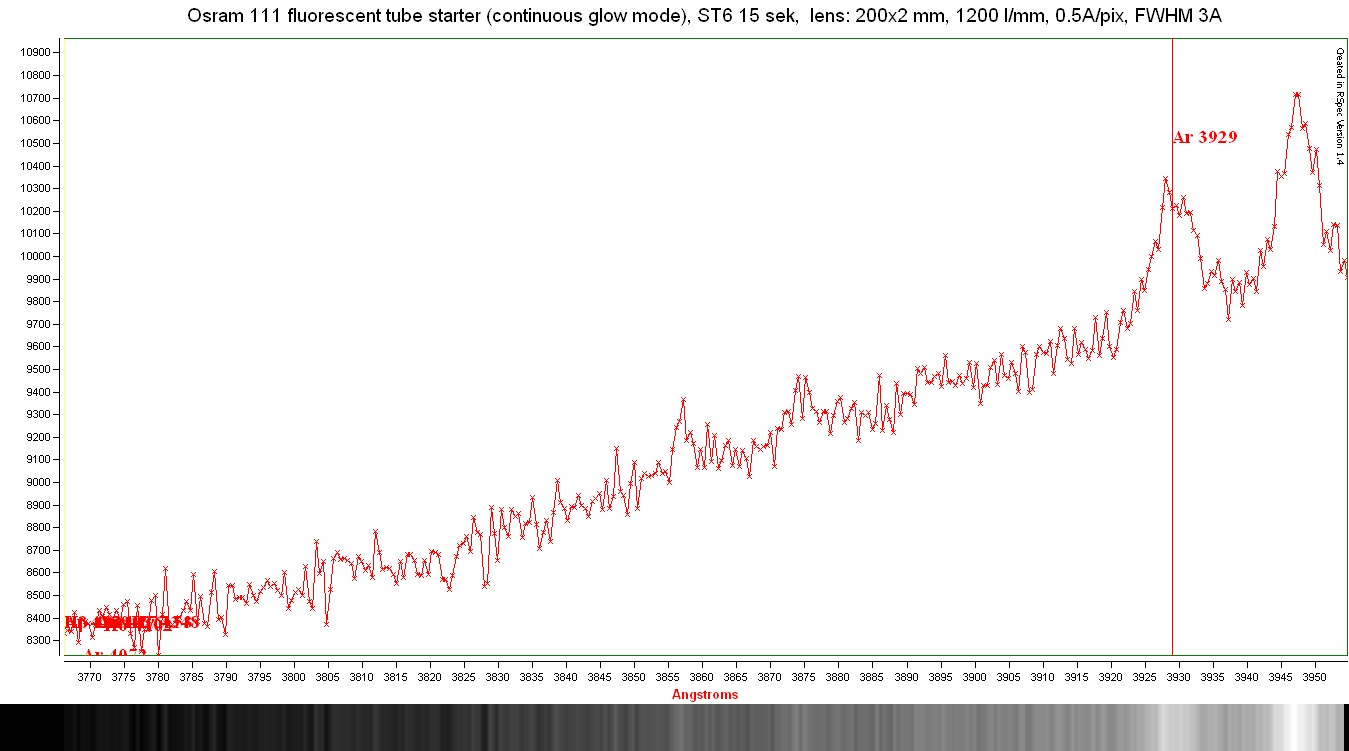
Moving on into the ultraviolet, the response of the camera fades, but we have enough senitivity to record the famous Fraunhofer K and H lines of neutral Calcium at 3933, 3968 Anstroms respectively. These lines are strong on the Sun and other stars near the G-type! Only two Argon lines are visible here.
Pure Neon glow lamp (Ne). Test with the ST6
In your stove or washing machine, you probably have a Neon lamp. This can be bought cheaply from an electronics store or appliance store. A 5mW Neon lamp has been tested below. A neon bulb like this is a "pure emitter" with only neon lines on a dark background, with a forest of lines from 5800 to 7500 A, around the Hydrogen Alpha line, so it is useful for calibration and measurement of Doppler shift in this region of the spectrum.
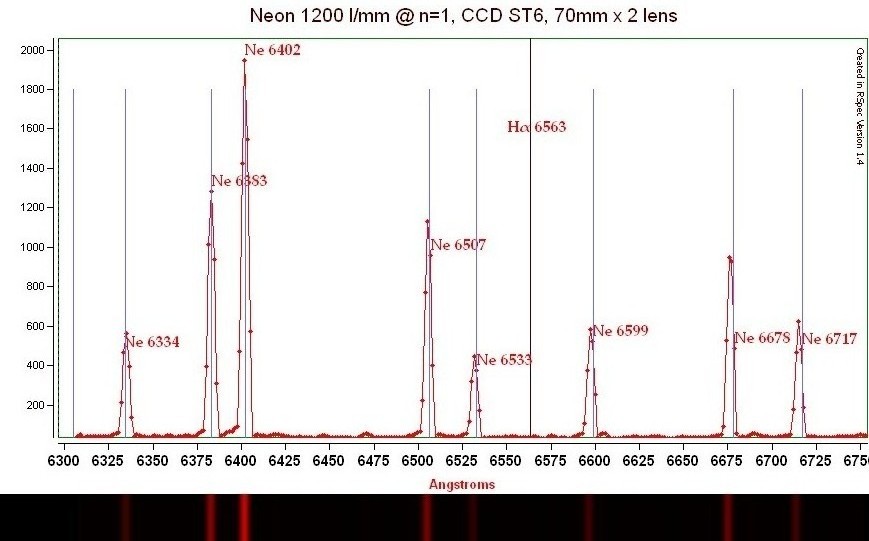
A 450 A "wide sweep" of the Neon spectrum near the Hydrogen alpha wavelength range, at low sampling rate. (Note there is no Hydrogen alpha line here - only neon lines!)
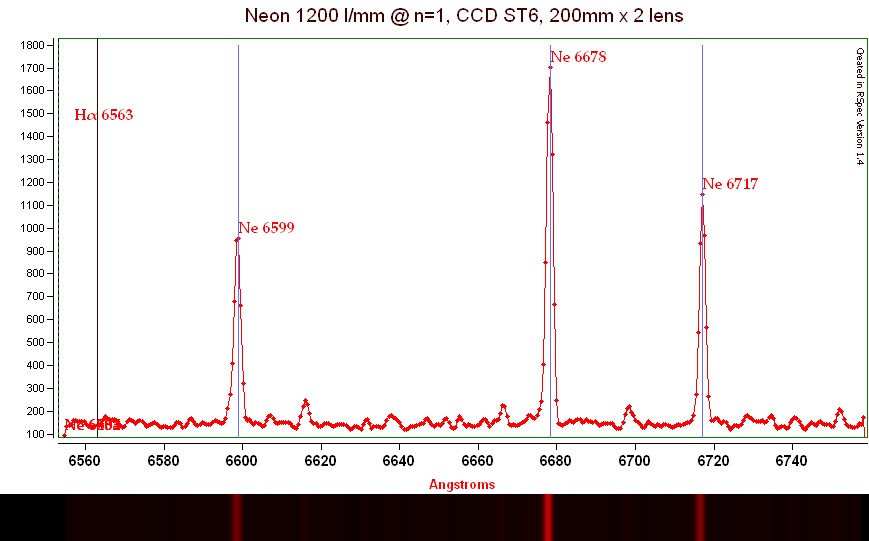
A 200 A range of the Neon spectrum near Hydrogen alpha, at the highest sampling rate.
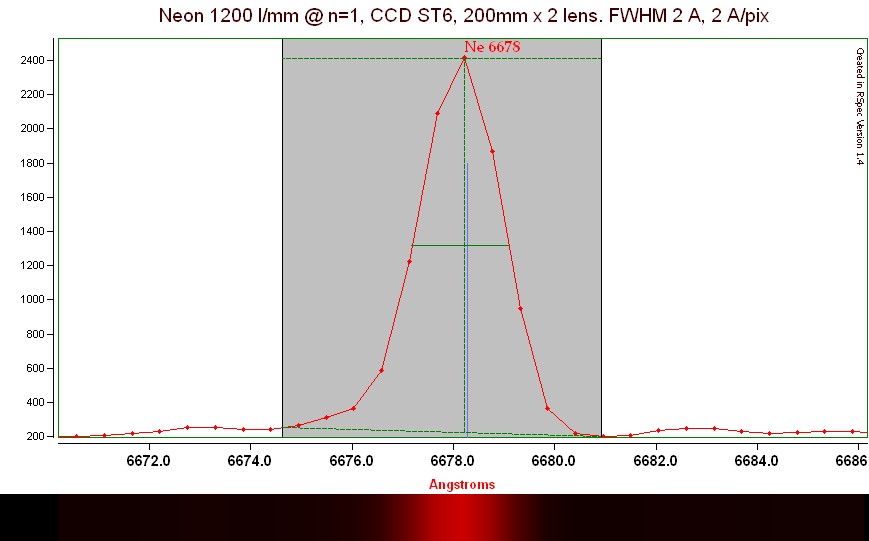
At the highest sampling rate, we obtain a FWHM of about 2 A, which is close to the instrument response and resolution, provided that the intrinsic neon line is much narrower. This corresponds to a resolution parameter R=6680/2 = 3340. The actual resolution of the instrument is somewhere between 1 and 2 A, since the neon lines have finite widths due to excitation lifetime and thermal broadening (how much, was not established).
 This is an Osram energy savings fluorescent bulb. Unfortunately, these have Mercury in them, but it makes a good calibration lamp with some sharp lines. However, a huge bulb like this suits best outside the spectrograph or in front of the telescope in combination with a diffuser.
This is an Osram energy savings fluorescent bulb. Unfortunately, these have Mercury in them, but it makes a good calibration lamp with some sharp lines. However, a huge bulb like this suits best outside the spectrograph or in front of the telescope in combination with a diffuser.
 Zoomed version. We see a spectral resolution of about 2 Angstroms (FWHM - Full Width Half Modulation; assuming that the profiles are purely an instrument response arising from a "delta function" for the true line profile, which is not really accurate) obtained at n=1 with a sampling rate at 0.2 Angstroms per pixel. Canon 450D camera. The asymmetric shape of the profiles may be an instrument artifact.
Zoomed version. We see a spectral resolution of about 2 Angstroms (FWHM - Full Width Half Modulation; assuming that the profiles are purely an instrument response arising from a "delta function" for the true line profile, which is not really accurate) obtained at n=1 with a sampling rate at 0.2 Angstroms per pixel. Canon 450D camera. The asymmetric shape of the profiles may be an instrument artifact.
 This is the Hydrogen Alpha line, plus some Argon emission, taken with the ST6 camera.
This is the Hydrogen Alpha line, plus some Argon emission, taken with the ST6 camera.
 Moving on towards the blue, we enter Hydrogen Beta with some Argon, and possibly a continuum in the background.
Moving on towards the blue, we enter Hydrogen Beta with some Argon, and possibly a continuum in the background.
 With a 200 mm lens with a 2x teleconverter one obtains one half the sampling rate (0.5 Angstrom/pix vs 0.2) with the ST6 as compared to the Canon camera with the single 200 mm lens (ST6 has larger pixels). The FWHM was here measured at 3 Angstroms. Only a subsection of the spectrum is shown.
With a 200 mm lens with a 2x teleconverter one obtains one half the sampling rate (0.5 Angstrom/pix vs 0.2) with the ST6 as compared to the Canon camera with the single 200 mm lens (ST6 has larger pixels). The FWHM was here measured at 3 Angstroms. Only a subsection of the spectrum is shown.
 Moving on further towards the blue, we enter Hydrogen Gamma with some Argon.
Moving on further towards the blue, we enter Hydrogen Gamma with some Argon.
 Moving on even further towards the blue, we enter Hydrogen Delta and possibly Epsilon (?), with some Argon.
Moving on even further towards the blue, we enter Hydrogen Delta and possibly Epsilon (?), with some Argon.
 Moving on into the ultraviolet, the response of the camera fades, but we have enough senitivity to record the famous Fraunhofer K and H lines of neutral Calcium at 3933, 3968 Anstroms respectively. These lines are strong on the Sun and other stars near the G-type! Only two Argon lines are visible here.
Moving on into the ultraviolet, the response of the camera fades, but we have enough senitivity to record the famous Fraunhofer K and H lines of neutral Calcium at 3933, 3968 Anstroms respectively. These lines are strong on the Sun and other stars near the G-type! Only two Argon lines are visible here.
 A 450 A "wide sweep" of the Neon spectrum near the Hydrogen alpha wavelength range, at low sampling rate. (Note there is no Hydrogen alpha line here - only neon lines!)
A 450 A "wide sweep" of the Neon spectrum near the Hydrogen alpha wavelength range, at low sampling rate. (Note there is no Hydrogen alpha line here - only neon lines!)
 A 200 A range of the Neon spectrum near Hydrogen alpha, at the highest sampling rate.
A 200 A range of the Neon spectrum near Hydrogen alpha, at the highest sampling rate.
 At the highest sampling rate, we obtain a FWHM of about 2 A, which is close to the instrument response and resolution, provided that the intrinsic neon line is much narrower. This corresponds to a resolution parameter R=6680/2 = 3340. The actual resolution of the instrument is somewhere between 1 and 2 A, since the neon lines have finite widths due to excitation lifetime and thermal broadening (how much, was not established).
At the highest sampling rate, we obtain a FWHM of about 2 A, which is close to the instrument response and resolution, provided that the intrinsic neon line is much narrower. This corresponds to a resolution parameter R=6680/2 = 3340. The actual resolution of the instrument is somewhere between 1 and 2 A, since the neon lines have finite widths due to excitation lifetime and thermal broadening (how much, was not established).